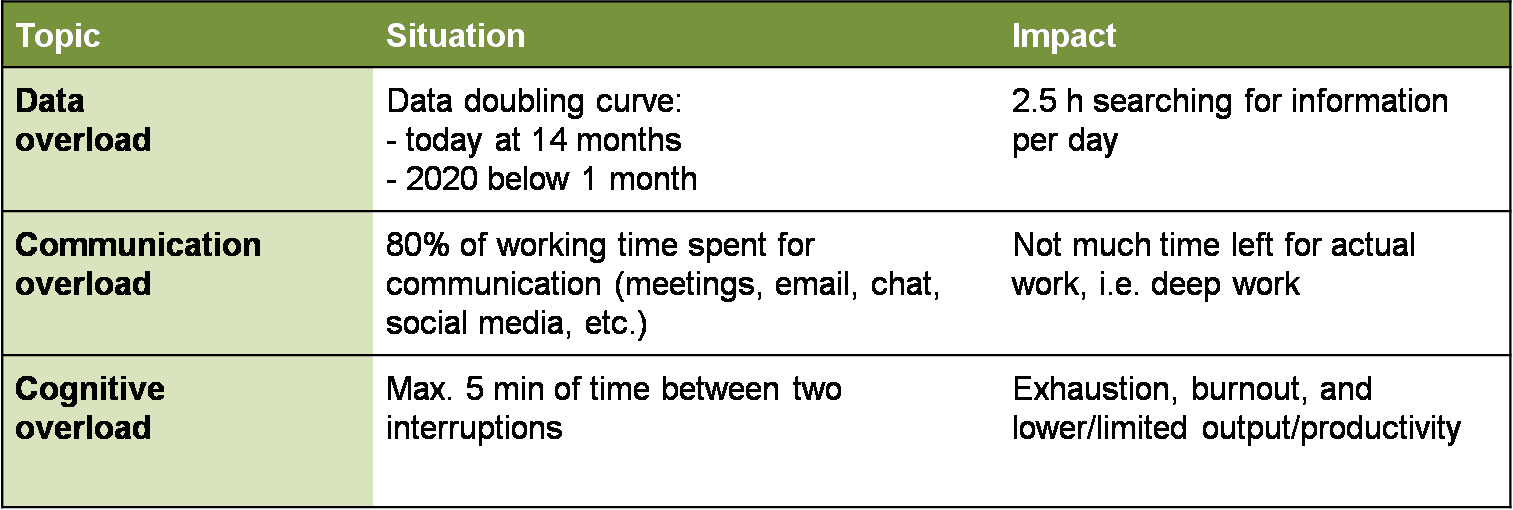Managing Digital Transformation
Abstract
Being successful in today’s digitized world partially requires new approaches and a new skill set. What has worked in the past may not always work again. While the digital age offers many opportunities arising from new data, it also poses a significant challenge with regard to constant distractions and multiple areas of information and data overload. The following chapter explains why digital transformation cannot be neglected, illustrates what has changed, shows the implications of those changes, and ends with a checklist of practical recommendations.
1) Digital Transformation Seems to Be Nothing Special
Over the last few centuries, we have seen constant changes in the business environment. The First Industrial Revolution (steam and mechanical production) started around 1780, when companies and leaders had to adapt to new circumstances and, hence, had to learn new skills. The same occurred during the Second Industrial Revolution (electricity and mass production) as well as the Third (IT and automation). At first sight, there is nothing new or special nowadays. According to Klaus Schwab (2016), “now a Fourth Industrial Revolution is building on the Third, the digital revolution, that has been occurring since the middle of the last century. It is characterized by a fusion of technologies that is blurring the lines between the physical, digital, and biological spheres.”
Yes, the current revolution looks like it involves more changes happening at once, but it is still not unique. So, why is there such a hype about the Fourth Industrial Revolution, especially about the digital transformation? Is the digitalization just another management fad? Or are companies and leaders required to understand a crucial difference to survive?
2) The Difference: Speed, Number of Changes and Trend Scouting
The industrial revolution happening now has one significant difference compared to the previous ones: speed. Constantly increasing computation power and storage capacity at a lower cost are allowing researchers to make greater progress in shorter periods of time. Such progress leads to more changes and new trends that need to be evaluated. Those changes impact our businesses and private lives with increased frequency. Who has not heard the phrase “change is the only constant”? Fifty years ago, a board member had to deal with a maximum of one large, truly relevant change during his or her tenure. But now, a new breakthrough seems to occur every four to five years (e.g., the Internet, Wi-Fi, mobile phones, robotics, artificial intelligence, and machine learning, just to name a few). What are the business implications of the massive number of changes we all have to undergo? How do we deal with this situation of constant information overload?
Changes are interconnected with emerging trends. Considering the failures of Nokia, BlackBerry or Kodak, ignoring megatrends may hurt a business significantly or even lead to bankruptcy. However, trend scouting is complex. Often, trends are overestimated in the beginning and then underestimated after the initial hype fades. A great example is the print newspaper industry. You might recall how, around 1998, scholars claimed that in a few years, there would no longer be any printed newspapers. In his Harvard Business Review (HBR) article (2014, p. x), Roger Martin said “It’s only in the last ten years that the Internet has really started to kill newsprint and newspapers.” As changes do not manifest overnight, constant trend scouting and trend weighting are essential.
3) Managing the Triple Overload Challenge: 14 - 2.5 - 80 - 5
Besides speed, there is another major difference between the current and the former Industrial Revolutions. There is an increasingly significant challenge that is often underestimated or not even dealt with at all: the triple overload challenge (data, communication, and cognitive) of the First World business environment. If you are wondering about the title of this section (14 – 2.5 – 80 – 5), you will find the solution to the riddle below (italicized). According to Richard Buckminster Fuller’s knowledge doubling curve, today’s data doubles every 14 months. Schilling (2013) argues that data will soon double every 12 hours. As the information and data overload seems to worsen over time, let us look at the triple overload more closely:
1. Data overload:
Various research papers (e.g., Ebert, 2014; Guest, 2013; Webster, 2012) indicate that because of the data overload, the average knowledge worker wastes about 2.5 hours per day searching for information, which is not productive at all. Given the vast data growth expected, investing in an efficient information-retrieval solution for your company is therefore essential for future success. Furthermore, finding information is key to preventing duplication of work, too.
2. Communication overload:
Cross et al. (2016) show in their HBR article that knowledge workers spend about 80% of their labor time communicating or collaborating (e.g., through emails, meetings, chat, and messenger). As a result, not much time remains to do deep work (Newport, 2015).
3. Cognitive overload:
Almost a decade ago, Pattison’s (2008) as well as Hemp’s (2009) research revealed that a knowledge worker gets interrupted or switches tasks every 3-5 minutes on average, leading to a very unhealthy cognitive overload, and finally exhaustion.
All three forms of overload together represent a serious challenge, be it for productivity or health reasons (i.e., burn-outs). Figure 1 offers a simple overview of the triple overload challenge.

Figure 1: The Triple Overload Challenge and its impact
4) Data: The New Business Oxygen - If a Culture of Failure Exists
Thanks to the increasing amount of data available, today’s business environment allows leaders to do less guesswork. This might be considered beneficial, but it requires a fundamentally new approach to management in order to turn it into something positive: Measuring and testing repeatedly have to become our state of normalcy. Learning quickly is more important than finding a perfect solution that is outdated at its launch. Moreover, it is crucial to have key performance indicators (KPIs) at all levels which are, ideally, shared with the entire company. Such transparency is a strong signal of inclusion for employees. Of course, speed is instrumental when it comes to working with data, too. Knowing in six months what you should have done six months ago is useless. Analyzing and interpreting data on a daily basis is key. Therfore, I highly recommend having the following two job profiles in every company (or at least individuals conducting the following two tasks regularly):
Data scientist: individuals who are able to transform multiple megabytes of data into a few easily legible diagrams and tables
Data sense maker: individuals who are capable of interpreting those diagrams and drawing conclusions quickly
In order to be successful in the digital transformation process, KPI dashboards are required at all levels: the board, middle management, and individual contributors. However, just having KPI dashboards is not enough; they need to be used regularly. Working with data has to enter the company’s DNA (Dahlström, 2017). It has to become part of the daily routine for the top management as well as for the board.
Next, you should make sure your IT department is an enabler and not a blocker of the digital transformation. (The latter may say “No, there is no time.” or “No, that is not on my yearly plan; log a ticket.” or “I (=> the CIO) decide who uses what software and hardware,” or something similar.) In order to transform your IT department to be a true enabler for digital transformation, make sure you have the right CIO – a person who loves working with data and has a genuine interest in trying new and even un-tested approaches (testing, testing, testing). One final observation is that the latest trends in this area are called bring your own device (BYOD) and bring your own app (BYOA). Productivity is personal, so in most cases, it makes sense to give your staff more freedom regarding how to get the work done.
5) Recommendations for a Successful Digital Transformation
- Digital transformation is a board and CEO topic and cannot be entirely delegated to the middle management.
- Make measuring, testing, and working with internal and external data part of your company DNA (Dahlström, 2017).
- Create KPI dashboards at all levels; update them regularly, and share them with your employees. Transparency builds trust.
- Do not forget to practice trend scouting and trend weighting on a regular basis.
- Create a culture of failure, even at the very top, and talk about it publicly (sharing, sharing, sharing).
- Think strategically, but act short-term (e.g., conducting 2-3 tests per quarter). Try, fail fast, learn, and apply what you learn right away. It is not the strongest who will survive, but those most adaptable to change.
- Consider the triple overload challenge and address it appropriately. Reduce searching time, prevent duplication of work, and lower unproductive communication to give more room for actual deep work.
- Do not think and operate in online and offline silos. The world is noline (a term often used by Google). In other words, there is no line any more between online and offline. So, are you a noline company?
- “Fast is better than slow” is one of Google’s internal rules of innovation. Speed beats perfectionism in most cases. It requires a culture of failure and a fail-fast-learn-fast mindset.
- Is your IT department a blocker (aka a naysayer) or an enabler for the digital transformation? Hire a CIO with the right mindset. Allow BYOD and BYOA wherever possible to boost your staff’s productivity.
- Conduct a digital maturity check (http://www.digital-maturity-check.ch/. In case the survey is not live (e.g. being updated), you may go through the survey questions yourself here.
Dr. Beat Bühlmann, General Manager, Evernote EMEA

Dr. Beat Bühlmann is General Manager at Evernote EMEA and an expert in digital transformation, customer journey analysis, and strategic online marketing. Prior to joining Evernote, he worked for Google and Dell in Zurich, London, and Geneva. Bühlmann grew up in a countryside, family-run hotel and started his career with a four-year apprenticeship as a car mechanic. He holds an engineering degree in Computer Science, an EMBA from the University of Applied Science in Zurich and a Doctorate in Business Administration from the University of South Australia in Adelaide. He is author of two books (1, 2), part-time MBA and Board School teacher, recognized expert in virtual team management, and board member of three SMB companies.
 News
News
Kommentieren